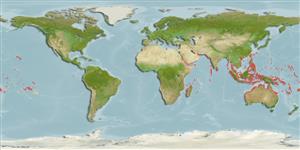Common names from other countries
>
Ovalentaria/misc (Various families in series Ovalentaria) >
Pomacentridae (Damselfishes) > Glyphisodontinae
Etymology: Abudefduf: Arabic, abu = father; this fish is the leader of the reef against other species (Ref. 45335).
More on author: Forsskål.
Environment: milieu / climate zone / Tiefenbereich / distribution range
Ökologie
seewasser; brackwasser riff-verbunden; standorttreu; tiefenbereich 0 - 3 m (Ref. 4391). Tropical; 27°N - 37°S, 49°W - 126°W (Ref. 56028)
Indo-Pacific: Red Sea and East Africa to the Hawaiian and Pitcairn islands, north to Japan, south to Australia.
Size / Gewicht / Alter
Geschlechtsreife: Lm ? range ? - ? cm
Max length : 24.0 cm TL Männchen/unbestimmt; (Ref. 90102)
Rückenflossenstacheln (insgesamt) : 13; Rückenflossenweichstrahlen (insgesamt) : 14 - 16; Afterflossenstacheln: 2; Afterflossenweichstrahlen: 14 - 15.
Body shape (shape guide): short and / or deep; Cross section: compressed.
Inhabit rocky lagoons, reef flat shorelines and piers subject to mild surge; juveniles are common in tide pools (Ref. 9710). Benthopelagic (Ref. 58302). Occasionally form schools. Feed on algae, crustaceans and other invertebrates during the day. Oviparous, distinct pairing during breeding (Ref. 205). Eggs are demersal and adhere to the substrate (Ref. 205). Males guard and aerate the eggs (Ref. 205). Highly territorial (Ref. 9710). Utilized as a food fish by the Hawaiians (Ref. 7364).
Life cycle and mating behavior
Geschlechtsreife | Fortpflanzung | Ablaichen | Eier | Fecundity | Larven
Oviparous, distinct pairing during breeding (Ref. 205). Eggs are demersal and adhere to the substrate (Ref. 205). Males guard and aerate the eggs (Ref. 205).
Allen, G.R., 1991. Damselfishes of the world. Mergus Publishers, Melle, Germany. 271 p. (Ref. 7247)
IUCN Rote Liste Status (Ref. 130435: Version 2025-1)
Bedrohung für Menschen
Harmless
Nutzung durch Menschen
Fischereien: weniger kommerziell; Aquarium: Kommerziell
Tools
Zusatzinformationen
Download XML
Internet Quellen
Estimates based on models
Preferred temperature (Ref.
123201): 24.7 - 29.3, mean 28.4 °C (based on 2750 cells).
Phylogenetic diversity index (Ref.
82804): PD
50 = 0.5000 [Uniqueness, from 0.5 = low to 2.0 = high].
Bayesian length-weight: a=0.02455 (0.01335 - 0.04514), b=3.11 (2.95 - 3.27), in cm total length, based on LWR estimates for this species & Genus-body shape (Ref.
93245).
Trophic level (Ref.
69278): 2.9 ±0.0 se; based on diet studies.
Widerstandsfähigkeit (Ref.
120179): mittel, Verdopplung der Population dauert 1,4 - 4,4 Jahre. (Preliminary K or Fecundity.).
Fishing Vulnerability (Ref.
59153): Low vulnerability (14 of 100).
🛈
Nutrients (Ref.
124155): Calcium = 71.2 [35.8, 112.8] mg/100g; Iron = 0.593 [0.351, 1.034] mg/100g; Protein = 18.8 [17.6, 19.9] %; Omega3 = 0.0879 [, ] g/100g; Selenium = 16.2 [8.3, 31.9] μg/100g; VitaminA = 69.8 [19.2, 240.5] μg/100g; Zinc = 1.69 [1.12, 2.56] mg/100g (wet weight);
